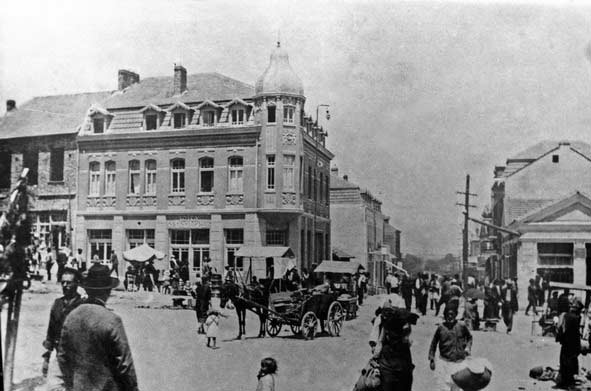Strumica is located in the south-east corner of Macedonia. With its population approaching 100.000, Strumica is the major cultural and economic center of south-eastern Macedonia.
The clear star-covered night skies have lended the name to this southern Macedonian town. Namely, because the star-filled night sky covering the Strumica valley, this town was known in the antiquity as Astraion (The Town of Stars), and the local people called themselves Astrai. But the name did not persist for long, since the town was renamed Tiberiopolis, after the Roman army commander Tiberius. After the colonization by the Slavs, however, the town took its modern name Strumica. There are several versions about the reasons for this name. One of them is that the name is only a Slavic translation of the old name Astraion
But most people believe that Strumica was named after a beautiful young woman named Struma. The Tomb of Struma is located in the village of Veljusa. There are few legends who actually Struma was. One of them says Struma was King Marko’s sister. Another, however, claims that Struma was a daughter of an emperor and army commander who cursed his daughter for her body not to be taken by the ground when she dies. The legend continues to say that Struma was buried seven times after her death, but each time the ground “threw” her body out from the grave. Therefore, she was buried in stone casket above ground. Finally, a third theory maintains that the vault dates from the time of Alexander the Great.
The city is famous for its fortress Carski Kuli (Tzar’s towers). The fortress was erected on a hill southwest of Strumica. Intertestingly, the oldest findings speak of life in this area before the Roman Empire. The citadel is surrounded by a hard limestone wall, erected in the late antiquity. The acropolis is separated by an additional internal wall. The entry gate is marked by two towers from the 6th century, which were later renovated during the reign of Emperor Tiberius. Byzantine coins dating from the 12th and 13th have been found in the citadel.
Tiberipolis was an important religious center east of the river Vardar, as it was an Episcopal seat. Numerous churches dedicated to local martyrs were contructed, such as the one dedicated to the 15 local martyrs close to the citadel. Over the graves of the martyrs a basilica was constructed in the times of Emperor Iustinian I, of which only a fragment has remained. The basilica is a martyrium, built on the bodies of martyrs, which is the oldest way of building a Christian temple.
The citadel is a reminder of the fall of the medieval Macedonian state of Tzar Samoil in 1018.
The outcome of the battle of Belasica, near Strumica (1014), against the Byzantine Emperor Basil II, was unfortunate for the Macedonian Tzar. Over 14.000 of his men were blinded, except for every hundredth soldier, who had one eye left in order to lead his fellow soldiers back to Samoil. The sight of the blinded soldiers was too much for Samoil’s heart to take; Samoil died of a heart attack in 1014 Prilep.
Following Samoil’s reign was a brief period of silent fall of his Empire.
Strumica is the center of the spacious rich Strumica valley. Here are grown poppy (mak), cotton, tobacco, sesame, peanuts and anason, a rare culture which is used to produce the famous Macedonian whiskey – Mastika. All this enables, to develop the textile and food industry in Strumica.
The Church of St. Leontius from the 11th century is the most famous historical monument around Strumica. The locals also call it Vodocha, which means poking eyes (vadi-ochi). The legend states that it was here where the 14.000 soldiers were blinded by the Byzantine Emperor Basil II. According to a Hylendar act, this monastery is considered a bishop’s residency in the Strumica region. Today, this monastery is only for monks, while the monastery of the Holy Mother of Eleisa nearby is the nun’s monastery. The frescoes in St. Leontius’ chuirch are well preserved, which is quite fortunate, given that they greatly resemble the ones found in St. Sophia’s church in Ohrid.
Nearby is the Church of the Holy Mother of Eleisa, also from the 11th century. However, unlike church of St. Leontius, the interior of this church was badly damaged during the First World War, when the church was set on fire. Ironically, the only completely preserved composition from the original frescoes is “Coming down from hell” where two devils is presented, which is very rarely seen in churches.
Strumica is also known for the traditional Strumica carnival, which has its roots in the pagan tradition. The carnival takes place every year during the Christian Feast Trimeri, the first three days after the Day of Forgiveness, is also known as the three most strict days of the Great Easter fasting. Strumica is a member of FECC, the Federation of European Carnival Cities.
15 km away from Strumica is the Spa Banjsko, with its mineral streams considered to be the hottest in Macedonia (75C degrees). The remaining of the old Roman and Turkish baths are well preserved here.
The border with Bulgaria is 22 km from the town.
Current weather in Strumica

Virtual Macedonia
Republic of Macedonia Home Page
Here at Virtual Macedonia, we love everything about our country, Republic of Macedonia. We focus on topics relating to travel to Macedonia, Macedonian history, Macedonian Language, Macedonian Culture. Our goal is to help people learn more about the "Jewel of the Balkans- Macedonia" - See more at our About Us page.
Leave a comment || Signup for email || Facebook |
History || Culture || Travel || Politics



















